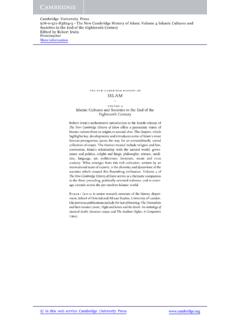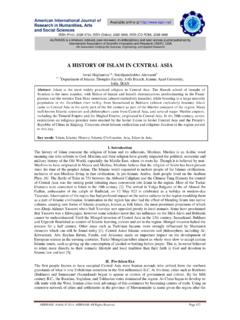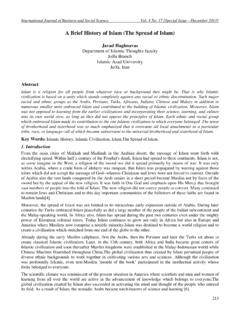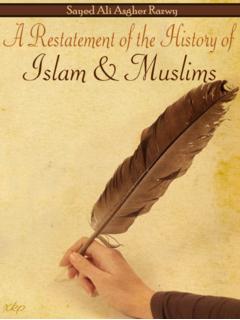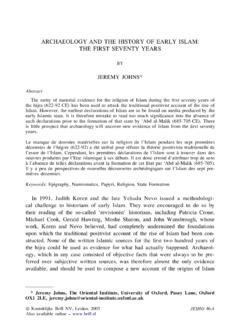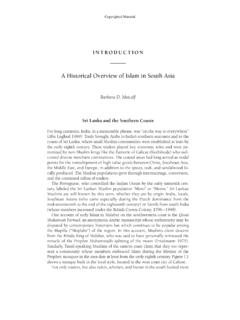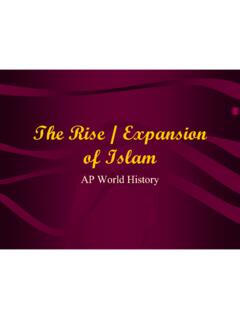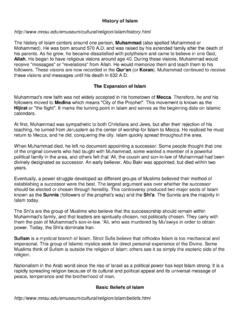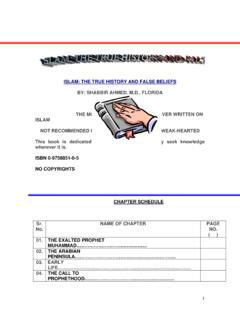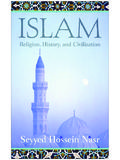Transcription of The History of the Qur'an
1 The History of the quran Part 1by Allamah Abu Abd Allah al-ZanjaniTranslated from the Persian by Mahliqa Qara iIntroduction:Praise be to Allah, Who teaches man that which he knows not. And benedic-tions be upon the Holy Prophet (S), who spoke the quran that guides mantowards that which is (still) peace be upon his Family (A) and hisCompanions who are the beacon of light in the the day of the revelation of the quran and its realization inthe tongue of the Arab Prophet (S), all Muslims, starting fromthe Companions of the Prophet (S), the Tabi un (the secondgeneration of Muslims who saw the Companions) Muslim 'Ulama'ulama andexperts in the art of recitation of the quran , have been showing suchgreat care and meticulousness that was never seen for any of theheavenly large number of books written about the Quranic sciencesever since the earliest Islamic centuries by the scholars, exegetes, thereaders of the quran and the intellectuals are enough to substantiate thisclaim.
2 In order to study it, discuss it and probe into the intricacies andmysteries of this Divine Book they travelled in various directions, andtraversed the untrodden paths and far-flung lands in order to pursuetheir academic the sixth/ twelfth century the European scholars alsofollowed the same path, imitating their Oriental counterparts, startedstudying the issues related to the History and exegesis of the quran andcompiling books on the quran and its commentaries methodically fromthe academic point of view with great the recent years, the Germans took up a great andcommendable job. The Scientific Society of Munich of presentGermany made great efforts regarding this Exalted Book, and decidedto collect all original sources related to the Holy quran and the bookswritten about the Quranic sciences, such as the exegeses and glossariesof Quranic terms, symbols and metaphors, by all possible G.
3 Bergstraesser (1) ,the German Orientalist and scholar, wasappointed for performing this task in view of his expertise. He startedworking in this field, and when he died in 1933 the aforementionedsociety assigned this job and its pursuance to Dr. Ottopretzl. Thisprofessor wrote a letter to the Academie Arabe of Damascus stating:For the convenience and information of our friends we have resolved to writeevery verse of the quran in specific pages copying from all the knownmanuscripts available to us, obtained from the old codices of the quran , withdifferent forms of recitation (qira at) as found in different text, along withtheir various expositions, which have been written and published during thecourse of time according to their successive order indicating the centuries, forthe common benefit of all with a view that all details put together may beaccessible to anybody who is interested in this subject, so that he may besaved from the trouble of referring to different books, exegeses and the first stage this institute took up the job of publishing themost significant books on the quran , such as al-Tuysir of Abu Amr Uthman ibn Sa id al-Dani (2), which deals with the seven ways of reading(qira'at)
4 The quran , and is regarded as one of the most accurate andauthentic books written about the science of reading the quran . Theother book is al-Muqni about the different styles of writing the Quranat different Islamic centres. Al-Nuqat written by al-Dani, Mukhtusur al-Shawadhdh by Ibn Khalawayh (3), al-Muhtasib by Ibn Jinni (4), which ispublished in the Latin script under the publications of the ScientificSociety of Munich, Ghayat al-Nihdyuh, about the classes of the readersof the quran al-qurra by Shams al-Din Muhammad al-Jazari (5) d. , Ma'ani al-Qur 'an by al-Farra ( 6 )and a treatise on the History of thescience of the quran in German language, which is a bibliography of thebooks written about the science of the quran that are present indifferent libraries all over the world.
5 The subject that was not paidattention to and scholars did not take much interest in is the History ofthe quran and the different phases since the day of the Holy Prophet(S) till the early Islamic era through which this book passed. If there arefound some studies in this field, they are merely concerned with thesciences of the quran . No book or compilation on this subject of greatsignificance and of general benefit that can cover all the issues relatedto this kind of study and solve the ambiguities of the problem has comeinto existence till compiling the present History of the quran (Ta rikh al- qur an )I started collecting the relevant material on this subject and its relatedissues from various books a long time ago, and examined it criticallyand carefully.
6 The present book presents a summary of my studies andresearches that actually forms a part of introduction to the exegesis ofthe quran , which I intend to compile in the manner of rational analysisand logical study of the quran . Accordingly, I am beginning this bookwith a short account of the character of the Prophet (S) that has beendrawn from trustworthy traditions and authentic sources. I hope thatthe readers will be benefited from this writing. God Almighty may havecompassion on me. Him alone I ask for (S), the Prophet of islam and the quran :As the Divine Law works in the system of creation to keep alivethe entire world of matter and existence with the light of the sun whichrevolves around its axis, similarly the Divine Law works in the directionof vitalizing the human soul by means of the prophets and propheticmission.
7 In the same manner as the rays emitting from the sun can bethe best guide for men in the world of existence to guide them towardslight, the rays of light emanating from the wahy (the Divine revelation)of the prophets are the best guide for men to lead them towards thebrightness ofthe Word of God. The Word of God, the Most High, thatwas revealed to the Prophet (S) is the Holy quran which is termed asthe Light in the following verse:..Now has come unto you the Light from God and a manifest God guides him who seeks His good pleasure unto paths of brings them out of darkness unto light by His decree, and guides themunto-a straightpath. (5:15-16)If you interpret this verse in historical context-in the early yearsof the early seventh century , you shall see that the conditions ofthe Middle Eastern countries as well as the Western world were in astate of turmoil.
8 The entire world was immersed in the darkness ofignorance and the masses were heading towards destruction and way-wardness. Human civilization and culture were meant nothing butluxuries of a few men, and their political life was under the shackles ofignorant ideas. Morality of the general public had reached its nadir dueto unhindered sensualities, and their beliefs were corrupted bycontinuous disputations and polemics. Their blood was shed byRajab-RamadBn, and tyrants without any sublime purpose and noble nations of the world had long ago lost their beauty and charm andwere leading an animal the juncture of this moral and intellectual degeneration, thebright light of Muhammad (S) appeared on the dark horizon for theguidance of this world that had gone astray, and gave a new life tothis lifeless body.
9 Carrying this Holy Book in his hands and holding fastthe ever-illuminating torch of tawhid (the principle of the Unity ofDivine Being) and guidance he invited the nations of the East and theWest to embrace this light. He transformed the indecent and disgracefulmanners of the inhabitants of the earth into righteousness and virtuous-ness. He built the belief-structure of the people on the basis of mutualkindness and forgiveness, and cemented their social relations by nurtur-ing among them a spirit of friendship and oneness. His struggle andefforts were all aimed at realizing the beauty of good conduct. He didneither have any worldly ambitions, nor did he intend to grab anyriches or to form an empire. His aim was to make the world a perfectlyimpeccable and civilized place by all possible means, and to emancipatethe human mind from the age-old fetters of ignorance.
10 He announcedthe immutable law of the freedom of reason to the world in thefollowing words:(O man), follow not that whereof you have no knowledge. Verily the hearingand the sight and the heart-of each of these it will be asked. (17:36)Here I present a glimpse of the character of this Prophet (S), andthe great reformer on the basis of the most authentic Birth of the Prophet (S):The -people who tried to investigate about the date of theProphet s birth faced two main hurdles in their investigation:1. The Arabs did not render their History into writing as writinghad newly developed at that The absence of any information concerning the calendarfollowed by the Arabs of jahiliyyah; we do not know whether theiryear was solar or lunar in order to determine the correct and exact dateof his birth in the month of Rabi al- Awwal, since the names of thepre-Islamic months also differed from what they are de Perceval (7) preferred lunar calendar as the calendarfollowed by the pre-Islamic Arabs.
